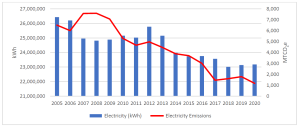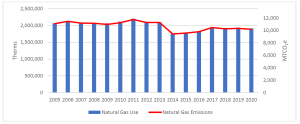How do buildings contribute to climate change and air pollution?
The built environment generates 40% of annual global greenhouse gas (GHG) emissions. Of those total emissions, building operations are responsible for 27% annually, while building and infrastructure materials and construction (typically referred to as ‘embodied carbon’) are responsible for an additional 13% annually.
In Fairfax, the built environment represents 37% of total GHG emissions. Electricity use in buildings contributes 4% of total emissions and natural gas use in buildings contributes 33% of total emissions. In homes, natural gas is most commonly used for water heating, space heating, and cooking.

Emissions from electricity use have decreased 83% since 2005 due to the lower carbon intensity of electricity resulting from PG&E and MCE increasing the amount of renewable energy in the electricity mix. MCE’s Light Green option is 92% carbon-free with a minimum of 60% of electricity sourced from renewables.
In contrast, emissions from natural gas use have only decreased 9% since 2005. The reduction can be attributed to a combination of factors including increased energy efficiency and electrification of buildings.

In addition to the GHG emissions that it creates, natural gas use in buildings is both a public health and safety risk. Gas use negatively impacts indoor air quality and presents the risk of gas leaks and combustion. Burning natural gas, especially in enclosed spaces indoors, can result in unhealthy levels of nitrogen dioxide (NO2), carbon monoxide (CO), and formaldehyde (HCHO). Several studies have confirmed that gas appliances, particularly gas stoves, often leak these toxic pollutants into the air and can be especially harmful for children and the elderly.
